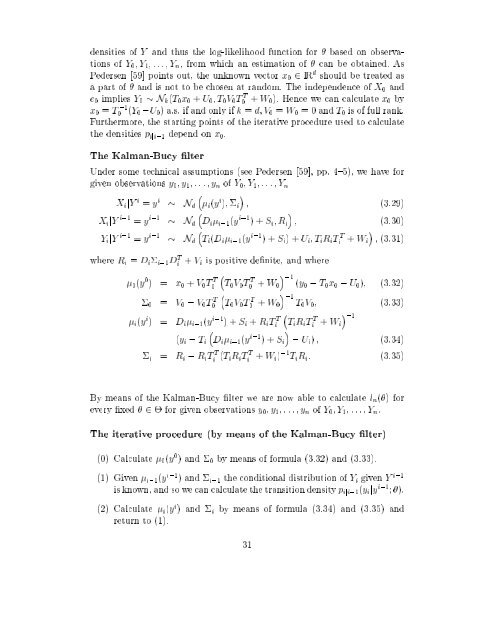Estimation in Financial Models - RiskLab
Estimation in Financial Models - RiskLab
Estimation in Financial Models - RiskLab
You also want an ePaper? Increase the reach of your titles
YUMPU automatically turns print PDFs into web optimized ePapers that Google loves.
densities of Y and thus the log-likelihood function for based on observations<br />
of Y 0 ;Y 1 ;:::;Y n , from which an estimation of can be obta<strong>in</strong>ed. As<br />
Pedersen [59] po<strong>in</strong>ts out, the unknown vector x 0 2 IR d should be treated as<br />
a part of and is not to be chosen at random. The <strong>in</strong>dependence of X 0 and<br />
e 0 implies Y 0 N k (T 0 x 0 + U 0 ;T 0 V 0 T T 0<br />
+ W 0 ). Hence we can calculate x 0 by<br />
x 0 = T ,1<br />
0 (Y 0 ,U 0 ) a.s. if and only if k = d; V 0 = W 0 = 0 and T 0 is of full rank.<br />
Furthermore, the start<strong>in</strong>g po<strong>in</strong>ts of the iterative procedure used to calculate<br />
the densities p iji,1 depend on x 0 .<br />
The Kalman-Bucy lter<br />
Under some technical assumptions (see Pedersen [59], pp. 4{5), we have for<br />
given observations y 0 ;y 1 ;:::;y n of Y 0 ;Y 1 ;:::;Y n<br />
X i jY i = y i N d<br />
<br />
i (y i ); i<br />
<br />
; (3.29)<br />
X i jY i,1 = y i,1 N d<br />
<br />
Di i,1 (y i,1 )+S i ;R i<br />
<br />
; (3.30)<br />
Y i jY i,1 = y i,1 N d<br />
<br />
Ti (D i i,1 (y i,1 )+S i )+U i ;T i R i T T<br />
i + W i<br />
<br />
; (3.31)<br />
where R i = D i i,1 D T i<br />
+ V i is positive denite, and where<br />
0 (y 0 ) = x 0 + V 0 T T 0<br />
<br />
T0 V 0 T T 0<br />
+ W 0<br />
,1<br />
(y0 , T 0 x 0 , U 0 ); (3.32)<br />
0 = V 0 , V 0 T T 0<br />
i (y i ) = D i i,1 (y i,1 )+S i + R i T T<br />
i<br />
<br />
T0 V 0 T T ,1<br />
0<br />
+ W 0 T0 V 0 ; (3.33)<br />
<br />
Ti R i Ti T ,1<br />
+ W i<br />
(y i , T i<br />
<br />
Di i,1 (y i,1 )+S i<br />
<br />
, Ui ) ; (3.34)<br />
i = R i , R i T T<br />
i (T i R i T T<br />
i + W i ) ,1 T i R i : (3.35)<br />
By means of the Kalman-Bucy lter we are now able to calculate l n () for<br />
every xed 2 for given observations y 0 ;y 1 ;:::;y n of Y 0 ;Y 1 ;:::;Y n .<br />
The iterative procedure (by means of the Kalman-Bucy lter)<br />
(0) Calculate 0 (y 0 ) and 0 by means of formula (3.32) and (3.33).<br />
(1) Given i,1 (y i,1 ) and i,1 the conditional distribution of Y i given Y i,1<br />
is known, and so we can calculate the transition density p iji,1 (y i jy i,1 ; ).<br />
(2) Calculate i (y i ) and i by means of formula (3.34) and (3.35) and<br />
return to (1).<br />
31
















